Pakistan's Currency - through annals of history
Since time immemorial, evolution of currency has passed through different phases. Chief among them are barter system, creation of first known currency by King Alyattes of Lydia1 in 600 BC, usage of coins and evolution of paper currency to the current movement towards cashless economies. Similarly, coins have also evolved through first usage in Lydia, Greek and Roman coins, to Indian and Islamic coins and finally, decimal coin system introduced in Pakistan in 1948. Regardless of currency’s form, the objective is the same i.e creation of a perfect value exchange medium to maximize efficiency in all transactions, resulting in the need for a universal lightweight substance. This has led to adoption of paper-based currency, its widespread usage and evolution through different phases to today’s paperless environment.
While the west is heading towards paper-less environment, in Pakistan’s labor-intensive, cash based economy where agriculture employs half the labor force and literacy rate is around 60%, it is understandable that the public still pose its trust in a tangible, seen and felt currency. Due to this preference, the Notes in Circulation are rising with each year, presently valuing Rs. 4.625 trillion2.
A currency is a medium of exchange as well as a country’s travelling history, depicting its glorious past and current prestige. Here, State Bank of Pakistan (SBP) is the sole issuer of currency notes, as per the State Bank of Pakistan Act 1956. Pakistan Security Printing Corporation (PSPC), established in 1949 as a private limited company prints all series for issuance. PSPC was commissioned in 1952, and printing started with the Re. 1/- note. The Government fully owned PSPC by April 1971 and in 2017, SBP acquired the banknote and prize bonds printing function as its fully owned subsidiary3. The issuance of coins in the country falls under the Government’s purview and their minting is undertaken through Pakistan Mint, Lahore Various issues of Pakistani Currency are as follow:
|


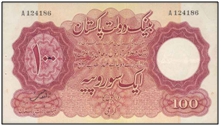
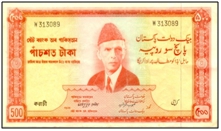
|
| |
|
Reserve Bank of India Issue
After their initial usage, Pakistan (Monetary System and Reserve Bank) Order, 1947” allowed modification and circulation of Indian notes. These modified notes, issued in Rs. 1, 2, 5, 10 and 100 denominations, contained two inscriptions on the front i.e. "Government of Pakistan" at top and “حکومت پاکستان “at bottom of the white area, generally reserved for viewing watermark
Government of Pakistan Issue
After SBP’s formation, Government of Pakistan (GoP) issued emergency banknote series on Oct 01, 1948, in Rs. 5, 10 and 100 denominations, printed by Great Britain’s Thomas De La Rue & Company. These notes, signed by Mr. Ghulam Muhammad, first Finance Minister of Pakistan, had neither watermark nor security thread. On Mar 01, 1949, SBP issued Re. 1 note printed by Bradbury Wilkinson & Company and signed by Mr. V. A Turner, Secretary Finance, Govt. of Pakistan4.
|
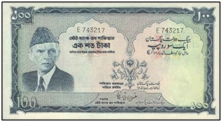 |
| |
|
State Bank of Pakistan– First Generation Series
On Mar 01, 1949,SBP issued its first generation of banknotes, initially in Rs. 2/- denomination, printed by Bradbury Wilkinson and company. These notes signed by the late Mr. Zahid Hussain, 1st Governor, SBP were printed in three languages i.e. English, Urdu and Bengali and incorporated security features like a crescent moon watermark and security thread.
In this generation, Rs. 5/- and Rs. 10/- printed by Thomas De La Rue & Company, were issued on Sep 01, 1951. On Sep 15, 1953, Rs. 100 note, printed by Thomas De La Rue & Company and PSPC was issued. All three denominations contained a watermark and security thread running through the note. |
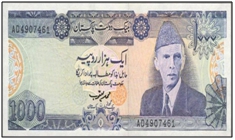
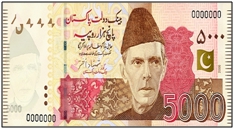
|
| |
|
State Bank of Pakistan – Second Generation Series
Security features of Pakistani currency have been evolving steadily. To ensure that every subsequent series is more secure, ever more sophisticated security features have been incorporated in various bank note generations. Accordingly, in 1956, it was decided to issue Rs. 100/- banknotes with a portrait of Father of the Nation, Quaid-e-Azam, Muhammad Ali Jinnah, along with a watermark also containing his photograph and the security thread. This note was issued on Dec 24, 1957. The use of portrait on this note set the trend for all subsequent issues of SBP. On Jun 12, 1964, Rs. 50 note was also introduced with promissory clause and the signatory’s designation, subsequently adopted for all other notes in this series.
|
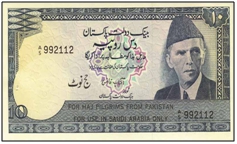
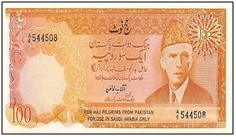
|
| |
|
State Bank of Pakistan – Third Generation Series
SBP has consistently undertaken all measures to ensure its currency is treated respectfully, with no personal/political purposes. To this end, on Jun 08, 1971 it was declared that all currency carrying political inscriptions was no longer legal tender, along with discontinuation of all Rs. 100/- and Rs. 500/- notes.
In line with the above policy and to combat any negative fallout resulting from East Pakistan’s secession, GoP demonetized the remaining notes in circulation and introduced a new banknote series, for which the design was kept the same while the colors of SBP second series were updated from blue to dark blue. The only new design note in this series was the Rs. 100 denomination.
|
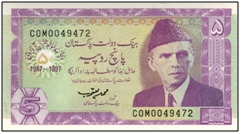 |
| |
|
State Bank of Pakistan – Fourth Generation Series
In order to ensure that every new series issued by SBP represents the whole society, the fourth generation series incorporated both Urdu and English inscriptions. On Apr 15, 1975, Re. 1/- note was issued, with its new design on Mar 24, 1981 by the government. On Jun 12, 1976, in a key implementation of the new series, Rs. 5/-, Rs. 10/- and Rs. 100/- notes were introduced whereas the Rs. 50 note was introduced on Dec 29, 1977. During 1982, all denominations were released with a line of Urdu text added to their back i.e. “رزق حلال عبادت ہے ”. On Feb 07, 1984, the SBP modified this line to read ‘’ حصول رزق حلال عین عبادت ہے ’’. Rs. 2/-, Rs. 500/- and Rs. 1000/- new notes were issued on Aug 24, 1985, Apr 01, 1986, and Jul 18, 1987 respectively.
|
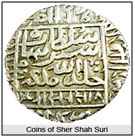 |
| |
|
State Bank of Pakistan – Fifth/ New Generation Series
With a view to further deter counterfeiting, the SBP , with the approval of federal government, decided to issue new design banknotes incorporating high-tech security features which minimize counterfeiting and increase efficiency of machine based note processing. These notes are printed at PSPC with a quality assurance mechanism that bring Pakistani Banknotes at par with modern, western banknotes.
On Aug 13, 2005, issuance of fifth generation banknotes was started with introduction of Rs. 20/- bank note first time in Pakistan’s history with added security features, followed by issuance of Rs. 10, 100, 500 and 5000 banknotes issued on Nov 11 and Nov 27,2006. On Mar 22, 2008, a new color scheme i.e. orange-green-yellow color for Rs. 20 denomination was introduced. The security features of new color banknote are similar to the previous Rs. 20 note in 2005. On Jul 08, 2008, new banknotes series of Rs. 5 and Rs. 50 were introduced.
|
 |
| |
|
State Bank of Pakistan – Special Issuance (Commemorative and Hajj Notes)
In May 1950, GoP allowed the SBP to issue Hajj Notes with same design, slight color variation and with an over print “حج نوٹ ” indicating specific usage. These notes were not legal tender in both East and West Pakistan as they were only allowed to pilgrims for purchasing Saudi riyals, to be remitted to Pakistan via the usual banking channels.
The SBP also makes concerted efforts to commemorate significant events in Pakistan’s history through issuance of commemorative currency, such as issuance of a special Rs. 5/- commemorative Rs. 5/- note on Aug 13, 1997, celebrating Pakistan’s 50th anniversary.
|
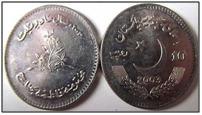 |
| |
|
Pakistani Coins
GoP issued its first coins in 1948, based on the traditional Rupees, Annas and Pice of the sub-continent, depicting crescent and star. In line with global decimal systems, Pakistan introduced decimal coinage on Jan 01, 1961. This decimal coinage was based on Rupee with division into paisas. 1, 5 and 10-paisa coins were issued in 1961, followed by 25 and 50 paisa coins in 1963. One Rupee coin was issued in 1977 on Dr. Allama Muhammad Iqbal’s 100th Birth Anniversary. Rs. 2, Rs. 5 and Rs. 10 coins were issued in 1998, 2002 and 2016 respectively. Similar to currency, SBP has also issued commemorative coins on occasions such as Father of the Nation Quaid-e-Azam Muhammad Ali Jinnah’s Birth Anniversary, Islamic Summit, Wild Life Conservation day, Poet of the East Allama Iqbal’s Birth anniversary, Advent of 15th century Hijra etc.
Recently, commemorative coins have been issued on Mother of the Nation Fatima Jinnah’s 110th Birth Anniversary, former prime minister Benazir Bhutto’s Death anniversary and laudatory coins paying tribute to humanitarian services rendered by the late Mr. Abdus Sattar Edhi and the late Dr. Ruth Pfau. SBP has also issued gold coins occasionally, such as the Rs. 500/- coin issued on the 100th Birth An niversary of Quaid-e-Azam in 1976, a Rs. 500/- commemorative coin issued on the 100th Birth anniversary of Dr. Allama Muhammad Iqbal in 1977 and the highest denomination coin i.e. Rs. 3000/- coin issued for the conservation of “Astor Markhor” in 1976. |
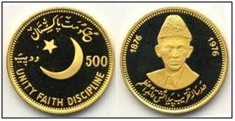
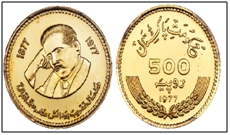
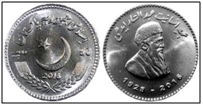
|
| |
|
Modern Usage & Machine Readability
In line with currency innovation, it is preferred that currency features be machine readable to deter counterfeiting and tempering. Accordingly, the fifth generation banknotes comprise both overt and covert features which enables public as well as high end stakeholders to assess banknotes’ authenticity. In March 2017 responding to the increased counterfeiting challenges, security features in higher denomination banknotes were further augmented for manual as well as machine recognition. These features run the gamut from enhanced inks to protective varnishing and infrared solutions.
Banknote design and security features are evolving with the advent of new technologies. Developed countries update their banknote series based on multiple factors such as new security technologies, new substrates, counterfeiting threats, country specific considerations etc. While there may be global security and design considerations, there are generally no set benchmarks for currency series updating or replacement. However, as per the global changing landscape, there are certain technologies, which based on their strength and durability are adopted globally. A significant example in this regard is the polymer substrate developed by Australia now adopted by around thirty countries globally, fully or as some denominations in a series. Some counties like Australia5 and Canada6 have converted fully to polymer banknotes. Others like the United Kingdom have a mix, with polymer based £5 and £10 banknotes in circulation7. SBP being fully cognizant of this rapidly changing landscape, is continuously working on evaluation and adaptation of better currency and security features, and is exploring the gradual adoption of polymer substrate through a structured feasibility study. SBP has also engaged an international consultant to evaluate the possibility of introducing polymer banknotes in Pakistan. If found feasible, SBP may in the first instance introduce a smaller denomination banknote on trial basis to assess public comfort and convenience.
|
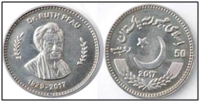 |
|